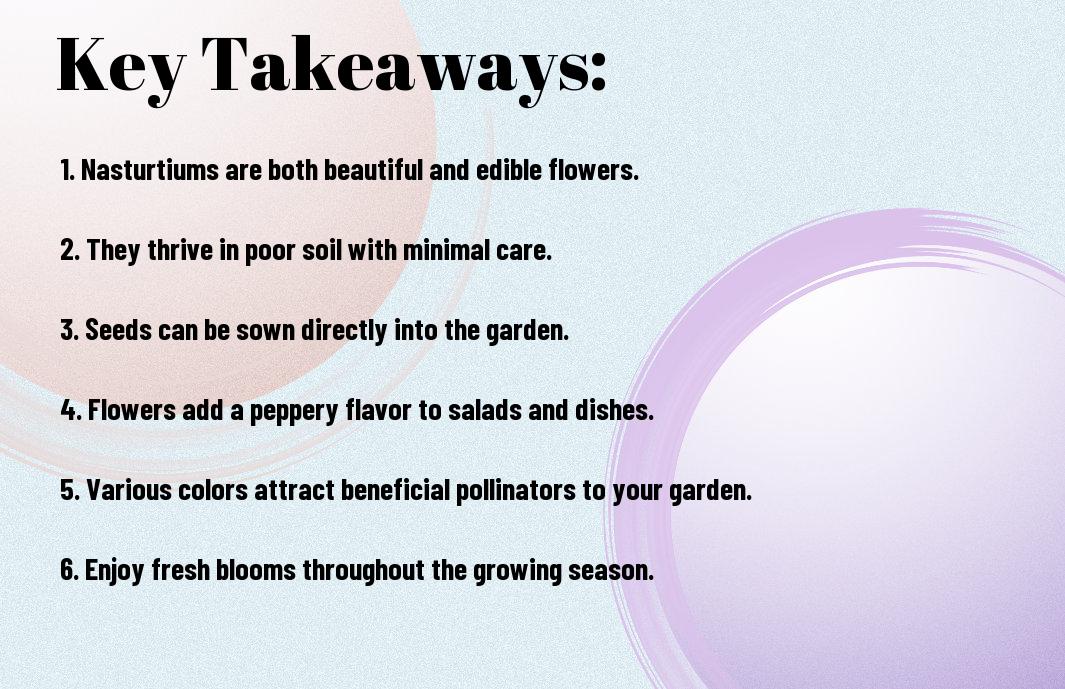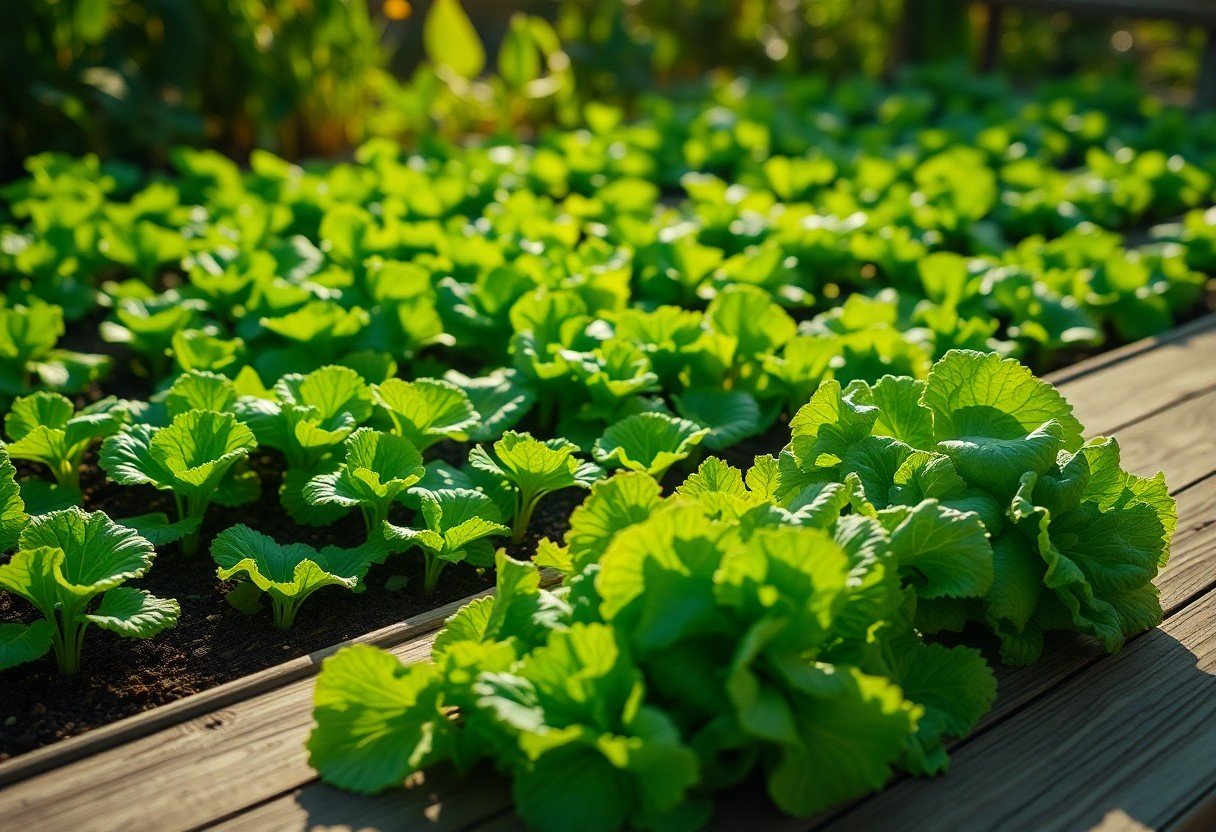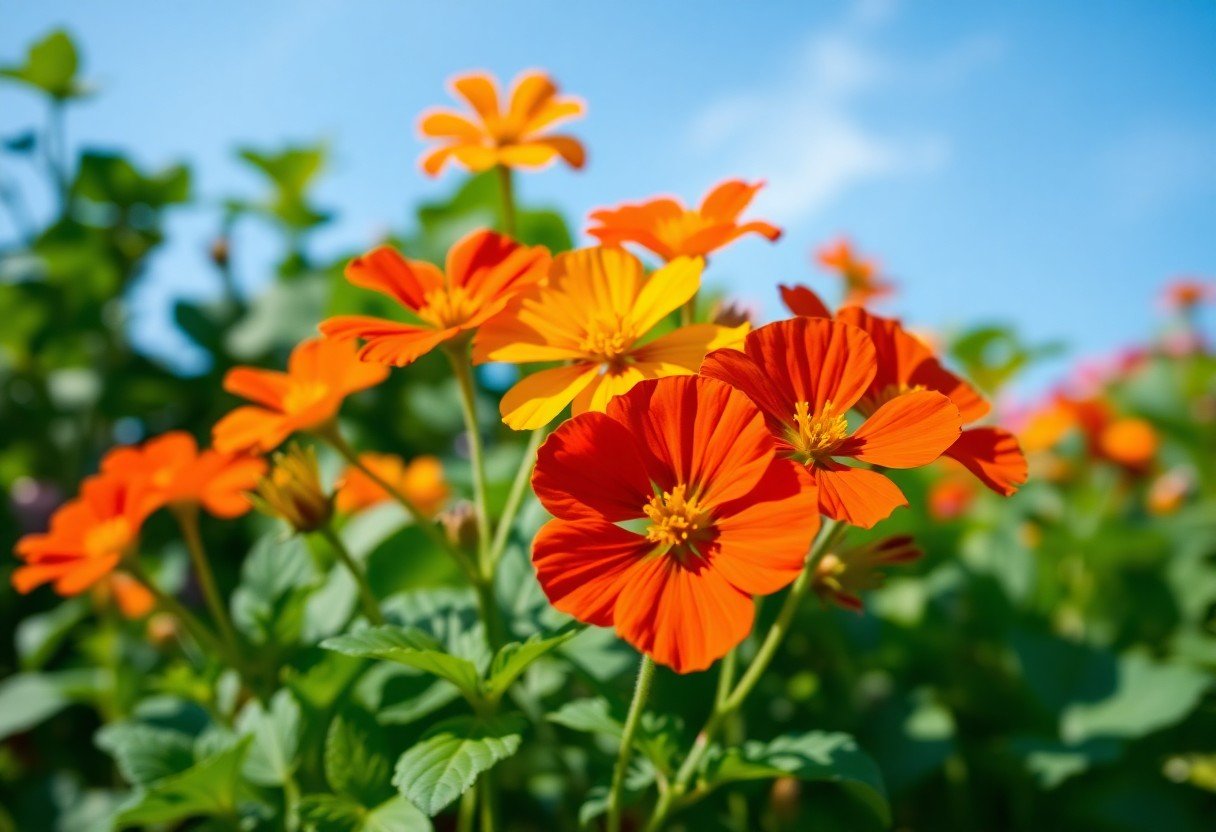Over the past few years, you may have come across the vibrant, edible blooms of nasturtium, a delightful addition to your garden and culinary creations. With their peppery flavor and striking colors, these flowers not only enhance your dishes but also bring a burst of beauty to your outdoor space. In this guide, you’ll discover easy steps to cultivate and utilize nasturtiums, ensuring a bountiful and visually appealing harvest right from your garden to your plate.

Key Takeaways:
- Nasturtiums are not only visually appealing but also serve as a flavorful addition to salads, soups, and other dishes.
- Growing nasturtiums is accessible, requiring minimal care and thriving in various conditions, making them suitable for beginner gardeners.
- The plant’s vibrant blooms can attract beneficial insects, enhancing biodiversity and supporting a healthier garden ecosystem.

Understanding Nasturtiums
To truly appreciate the beauty and benefits of nasturtiums, it’s important to examine into their characteristics, significance, and nutritional value. This vibrant plant not only enhances your garden but also offers a range of culinary and health benefits. Let’s explore what nasturtiums are, their historical importance, and their nutritional advantages.
What are Nasturtiums?
At their core, nasturtiums are annual flowering plants known for their bright, colorful blooms that range from yellows to deep reds. These plants belong to the Tropaeolum genus, and their leaves and flowers are edible, making them a popular choice for both ornamental and culinary uses. With a peppery flavor similar to arugula, nasturtiums can add a unique touch to your salads and dishes.
Historical Significance and Uses
Above all, nasturtiums have held a place in culinary and medicinal traditions for centuries. Native to South America, these plants were cherished by indigenous people for their vibrant colors and edible properties. European explorers introduced them to gardens worldwide, where they quickly became a staple not only for their beauty but also for their antibacterial and antifungal properties.
Further, nasturtiums were historically valued for their ability to attract beneficial insects to gardens, improving overall plant health. They were also used in folk medicine, serving as remedies for various ailments, including respiratory issues and minor infections. Today, you can incorporate them into dishes, making their history a flavorful part of your culinary adventures.
Nutritional Benefits
Before you decide to grow or consume nasturtiums, it’s important to know about their nutritional profile. These plants are packed with vitamins A, C, and K, along with minerals like iron and calcium. Their low-calorie count makes them a healthy addition to your lifestyle, perfect for enhancing a variety of meals.
In addition, nasturtiums possess antioxidant properties, promoting overall well-being. Their high vitamin C content can support your immune system, while their anti-inflammatory properties may contribute to reducing chronic diseases. By incorporating nasturtiums into your diet, you not only enjoy their unique flavor but also enhance your nutritional intake.
Varieties of Nasturtiums
Any garden enthusiast will appreciate the diverse array of nasturtium varieties available, each offering its unique charm and culinary benefits.
Common Types of Nasturtiums
At the heart of the nasturtium family are several common types that bring vibrant colors and flavors to your garden and plate. Here’s a quick breakdown:
| Variety | Traits |
|---|---|
| Tropaeolum majus | Large flowers, tall growth, ideal for trellises |
| Tropaeolum minus | Smaller flowers, compact growth, perfect for borders |
| Tropaeolum peltophorum | More delicate blooms, hearty foliage, and a unique taste |
| Tropaeolum tuberosum | Edible tubers, vibrant blossoms, truncated life cycle |
| Tropaeolum speciosum | Cascading growth, elegant flowers, great for hanging baskets |
The diversity in these varieties allows you to choose ones that complement your garden style and culinary needs.
Color Variations and Their Traits
Before selecting nasturtiums, take a moment to consider the different colors they offer, each enhancing your garden with its unique flair.
In addition to their distinctive flavors, nasturtiums come in a variety of colors such as bright orange, deep red, sunny yellow, and even pale cream. Each color shares similar textures but can slightly differ in taste; for example, orange blooms tend to be peppery and robust, while yellow blossoms often have a milder flavor. This palette not only adds visual excitement to your plantings but can also elevate your dishes with an array of delightful hues.
Selecting the Right Variety for Your Garden
The ideal nasturtium variety for your garden often depends on your available space and personal taste preferences.
Types to consider include taller varieties like Tropaeolum majus for vertical spaces and hanging baskets, or the compact Tropaeolum minus for border planting. If your goal is to add dynamic aesthetics, choose colorful varieties that will contrast with your existing flora. Additionally, think about your culinary usage; some varieties yield more flavorful blooms than others, so if you plan to harvest, select accordingly for an optimal experience.

Growing Nasturtiums
Many gardeners find growing nasturtiums to be an accessible and rewarding venture. These vibrant, edible blooms not only add color to your garden but also serve culinary purposes. To ensure a successful growth experience, you should pay attention to their ideal growing conditions.
Ideal Growing Conditions
To achieve optimal growth, nasturtiums thrive in full sun and appreciate warm weather. They prefer well-draining soil that isn’t overly rich, as too much fertilizer can lead to more foliage than flowers. Adequate sunlight enhances their vibrant blooms, making them not just edible but visually striking as well.
Soil Preparation and Planting Techniques
On preparing your garden bed, start by loosening the soil to a depth of about 12 inches. Remove any debris and weeds to prevent competition for nutrients. Sow seeds directly into the ground after the last frost, ideally about 1/2 inch deep and 10-12 inches apart. When positioning your nasturtiums, keep in mind their growth habits, whether you opt for trailing or bush varieties.
But be cautious with the density of your planting. If you pack them too closely, they can hinder air circulation and promote disease. It’s best to provide enough space for each plant to expand its reach, ensuring vibrant growth and healthy blooms. You may also consider starting seeds indoors if you want an early start.
Watering and Maintenance Tips
By establishing a consistent watering routine, you can help your nasturtiums thrive. These plants prefer moderate moisture, so aim to keep the soil lightly hydrated without over-watering. Regular maintenance will also enhance their growth.
- Water deeply but less frequently to encourage deep root systems.
- Mulch around the base to retain moisture and suppress weeds.
- Prune spent flowers to promote new growth.
Perceiving how your plants react to their environment will help you adapt your care routine effectively.
Even with proper maintenance, it’s vital to regularly inspect your plants for signs of stress or pests. Keep an eye out for yellowing leaves or wilting, as these can indicate underlying issues.
Common Pests and Diseases
Before you start noticing your nasturtiums wilt, be aware of common pests and diseases that can affect their health. Aphids, spider mites, and powdery mildew are some frequent troubles that can hinder your plants’ growth.
Even minor infestations can quickly escalate if not addressed. Consider using organic pest control methods such as insecticidal soap or neem oil. Furthermore, ensuring good air circulation and regular monitoring will aid in early detection and treatment of any issues.
Harvesting and Utilizing Nasturtiums
After nurturing your nasturtiums, it’s time to reap the rewards. Harvesting these vibrant, edible blooms not only adds beauty to your dishes but also allows you to enjoy the peppery flavor they bring. You’ll find that the process is both straightforward and satisfying, as you incorporate these delightful flowers into your culinary adventures.
When to Harvest
After a few weeks of growth, you can begin to harvest nasturtium flowers. Aim to pick the blooms in the morning when they’re fully open for the best flavor and freshness. Ideally, you should gather them just before you intend to use them, as this ensures your blooms are at their utmost peak in flavor and vibrancy.
Culinary Uses of Nasturtium Blooms
Culinary applications for nasturtium blooms are endless, and their distinct peppery flavor can elevate a variety of dishes. You can toss them into salads, use them as garnishes for soups, or blend them into herb butters for a flavorful twist.
This versatility makes nasturtiums a fantastic addition to your culinary repertoire. You can stuff the blooms with cream cheese, use them in herbal vinegars, or even incorporate their leaves into sandwiches for an extra kick. Their vibrant colors also make them an eye-catching feature on any plate, enhancing both taste and visual appeal.
Creative Presentation Ideas
Across your dining table, nasturtiums can be used to create stunning and vibrant presentations. Whether you’re serving a simple salad or hosting a festive gathering, the addition of these blooms can turn any dish into a masterpiece.
Harvest your nasturtiums and think beyond the plate; consider using them to decorate cakes or illuminating a charcuterie board. You can even freeze them in ice cubes for a stunning touch to summer cocktails. With a bit of creativity, nasturtium blooms can elevate your culinary creations and make every meal an occasion.
Gardening Techniques for Optimal Growth
Now that you are ready to cultivate your own patch of vibrant nasturtiums, it’s necessary to implement some effective gardening techniques to ensure they flourish.
Companion Planting with Nasturtiums
Before you plant nasturtiums, consider their compatibility with other garden favorites. These cheerful blooms thrive alongside a variety of plants like tomatoes, cucumbers, and radishes. Their ability to repel pests while attracting beneficial insects makes them an ideal companion. By integrating nasturtiums into your garden, you can create a thriving ecosystem that supports the overall health of your plants.
Organic Pest Control Methods
Techniques for organic pest control truly shine when you harness the protective qualities of nasturtiums. These plants naturally deter aphids, whiteflies, and cucumber beetles, effectively safeguarding your garden. When you plant nasturtiums, you’re adding a layer of defense against these common pests, allowing you to reduce the need for harmful pesticides while fostering a healthier garden environment.
Seasonal Care Practices
The key to vibrant nasturtiums lies in seasonal care. They thrive in well-drained soil and benefit from regular watering, especially during dry spells. Additionally, cutting back spent blooms encourages new growth and extends their blooming period, giving your garden an ongoing burst of color.
In addition to regular watering and deadheading, seasonal care involves monitoring temperatures and adjusting your planting schedule accordingly. Nasturtiums typically prefer cooler weather, so aim to plant them in early spring or late summer. Following these practices ensures your blooms remain lush and vibrant throughout their growing season.

Expanding Your Nasturtium Garden
Despite your initial success with nasturtiums, there’s always room to expand your garden. With a few simple steps, you can grow a more colorful and flavorful collection of these unique edible blooms. Whether you choose to propagate, diversify, or create innovative recipes, your nasturtium journey is just beginning!
Propagating Nasturtiums
Garden enthusiasts often find delight in propagating nasturtiums through seeds or cuttings. Starting indoors in soil or using a seed tray ensures that you can control their environment. Once the seedlings have established a few true leaves, you can transplant them outdoors for a burst of color and taste in your garden.
Creating a Diverse Edible Flower Garden
At the heart of an engaging garden lies diversity. Incorporating nasturtiums with other edible flowers, like pansies or calendulas, not only enhances the aesthetic appeal but also ensures a continuous pollinator presence. Mixing varieties with different colors and flavors offers a feast for the eyes and palate.
Even a modest garden can flourish with the vibrant colors and styles of various edible flowers. By selecting companion plants that thrive in similar conditions, you can create a tapestry of growth that attracts beneficial insects while providing a spectrum of flavors. Experiment with arrangements and heights to maximize your garden’s potential.
Innovative Recipes Featuring Nasturtiums
Behind those vibrant petals lies a world of culinary opportunity. Nasturtiums are not just for decoration; they can elevate your dishes with a peppery zest. You can blend them into salads, use them as a garnish, or even incorporate their leaves into sauces for a unique twist.
To truly maximize your nasturtium blooms, explore innovative ways to incorporate them into your cooking. Consider making nasturtium pesto, infusing their leaves into oils, or crafting delightful floral ice cubes to impress your guests. With every bite, you’ll not only savor the taste but also appreciate the visual beauty they bring to your dishes.
Summing up
Now that you have explored the easy steps to cultivate vibrant, edible blooms with the ‘Nasturtium Narratives’, you can confidently enhance your garden and culinary experiences. By selecting the right varieties, ensuring optimal growing conditions, and incorporating these beautiful flowers into your dishes, you’ll not only beautify your surroundings but also delight your taste buds. Embrace the journey ahead as you nurture your own nasturtium, transforming both your garden and palette with these remarkable plants.
FAQ
Q: What are the benefits of growing nasturtiums in my garden?
A: Growing nasturtiums offers numerous advantages. For one, these vibrant flowers are not only visually appealing but are also edible, adding a spicy flavor to salads and other dishes. Additionally, they serve as a natural pest deterrent, attracting beneficial insects while repelling harmful ones. Nasturtiums are also hardy plants that thrive in poor soil conditions, making them an excellent choice for novice gardeners.
Q: How can I incorporate nasturtiums into my culinary creations?
A: Nasturtiums can be used in various culinary applications. Their leaves, flowers, and seeds are all edible. You can add the peppery-flavored leaves to salads for a fresh taste or use the vibrant flowers as a garnish on plates. Additionally, you can make nasturtium pesto by blending the leaves with nuts, garlic, and olive oil, or pickle the seeds as a substitute for capers. Their versatility makes them a delightful addition to any meal.
Q: What steps should I follow to grow healthy nasturtiums?
A: To successfully grow nasturtiums, start by selecting a sunny location with well-draining soil. Sow seeds directly in the garden after the last frost, or start indoors a few weeks earlier. Water the plants regularly, but avoid overwatering, as they prefer slightly dry conditions. Fertilization is not necessary, as nasturtiums thrive in poorer soils. Finally, ensure they have proper spacing to allow airflow and prevent diseases. With minimal effort, you can enjoy a bounty of colorful blooms.











